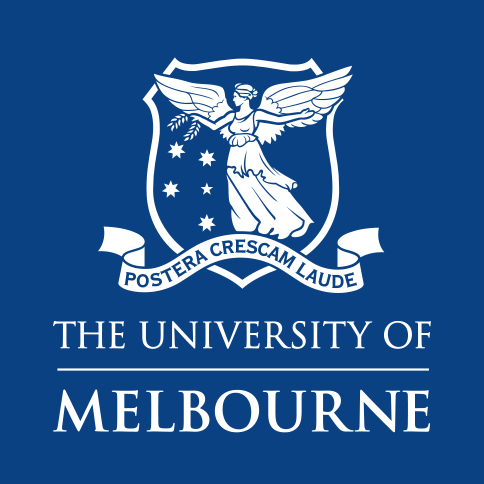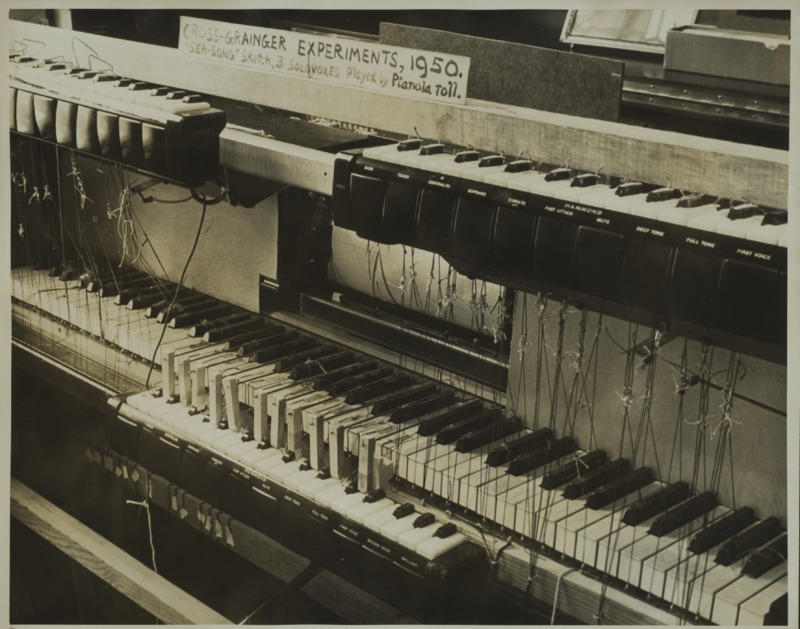Cross-Grainger experiments 1950: ‘Sea-Song’ sketch, 3 Solovoxes played by Pianola Roll.
Dublin Core
Title
Cross-Grainger experiments 1950: ‘Sea-Song’ sketch, 3 Solovoxes played by Pianola Roll.
Subject
Description
Unknown photographer, Cross-Grainger experiments 1950: ‘Sea-Song’ sketch, 3 Solovoxes played by Pianola Roll, 1950
Graphic reproduction of original photograph
Grainger Museum Archive, 99.5700
Grainger’s experimentation in electronic sound led him to investigate the capacity of the Hammond Solovox, which was manufactured between 1940 and 1948. The Solovox was a monophonic keyboard attachment instrument, which connected to an electronic sound generation box, amplifier and speaker. Grainger rigged up three of these instruments with his Duo-Art piano to explore electronic means of creating Free Music. In this experiment, he hand-cut a piano roll with a fragment of his Sea Song sketch (1907, 1922). The action of the piano keys pulled down the keys on each of the Solovoxes, which were tuned a fraction of a semi-tone apart. The effect, which you can hear on the recording he made of the experiments in February 1950, is quite eerie.
In these electronic experiments, Grainger anticipated multitrack recording, sequencing, and interactive performance with sequencers. Electronic keyboard instruments, like the Solovox, sat in a middle ground of electronic music production, being the electronic reproduction of conventional musical sounds. Grainger’s experiments tried to stretch the capabilities of the electronic organ into the realm of the synthesizer, which had a far wider range of possible sounds and sonic textures.
Graphic reproduction of original photograph
Grainger Museum Archive, 99.5700
Grainger’s experimentation in electronic sound led him to investigate the capacity of the Hammond Solovox, which was manufactured between 1940 and 1948. The Solovox was a monophonic keyboard attachment instrument, which connected to an electronic sound generation box, amplifier and speaker. Grainger rigged up three of these instruments with his Duo-Art piano to explore electronic means of creating Free Music. In this experiment, he hand-cut a piano roll with a fragment of his Sea Song sketch (1907, 1922). The action of the piano keys pulled down the keys on each of the Solovoxes, which were tuned a fraction of a semi-tone apart. The effect, which you can hear on the recording he made of the experiments in February 1950, is quite eerie.
In these electronic experiments, Grainger anticipated multitrack recording, sequencing, and interactive performance with sequencers. Electronic keyboard instruments, like the Solovox, sat in a middle ground of electronic music production, being the electronic reproduction of conventional musical sounds. Grainger’s experiments tried to stretch the capabilities of the electronic organ into the realm of the synthesizer, which had a far wider range of possible sounds and sonic textures.
Creator
Date
1950
Format
Graphic reproduction of original photograph
Identifier
99.5700


